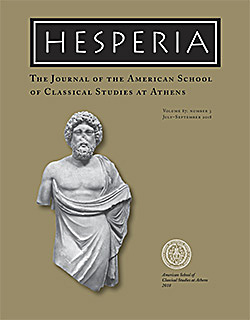Hesperia 87.3 Now Online!

The American School of Classical Studies at Athens is pleased to announce the publication of Hesperia 87.3. Topics in this issue include the examination of terracotta votives from Archaic Acrocorinth in the shape of sandaled feet, the survey and identification of defensive watchtowers at Mantineia, a study of Hippias of Erythrai and local historiography, and the presentation of the marble statuary of Asklepios from the Athenian Agora.
Subscribers can read the issue online at JSTOR, which now hosts all current issues of Hesperia as well as an archive of past volumes. The printed version will be mailed shortly.
Terracotta Models of Sandaled Feet: Votives from the Sanctuary of Demeter and Kore on Acrocorinth, by Sonia Klinger, presents four previously unpublished terracotta models of sandaled feet from the Sanctuary of Demeter and Kore on Acrocorinth. Dated to the late 6th or early 5th century, they are attributed to a local Corinthian workshop, most probably the Potters’ Quarter, where three other similar models were produced. Evidence deriving from the sanctuary’s other offerings, and from study of footwear in ancient texts and art, suggests that their main association is with female journeys connected to nuptial symbolism. This interpretation also allows for the proposal that the models are a type of bridal sandal (nymphides), the first attested in Corinth and the first associated with an Archaic sanctuary.
The Defense Network in the Chora of Mantineia, by Matthew P. Maher and Alistair Mowat, discusses how the ancient Greek city of Mantineia was safeguarded by a number of signal towers located along the periphery of its territory. Combining a review of the published literature with satellite reconnaissance and personal observation, this article is the first detailed architectural study and synthesis of all known Mantineian signal towers. Having examined their construction and location, and by applying viewshed analyses in the chronological and historical context of the region, the authors show how these signal towers, including two previously unknown examples, functioned together as parts of a larger defensive system built to protect both the polis and chora of Mantineia from all cardinal directions.
The Local History of Hippias of Erythrai: Politics, Place, Memory, and Monumentality, by Matthew Simonton, examines how studies of local historiography in ancient Greece have overlooked the importance of Hippias of Erythrai, whose lone surviving fragment reveals complex processes of memory making and the politics of place. He argues that Hippias should be understood as a participant in Early Hellenistic struggles between democracy and oligarchy, concluding with an exploration of how the historian’s language interacts with the text and iconography of a Late Classical Athenian monument.
The Statuary of Asklepios from the Athenian Agora, by Brian Martens, identifies and publishes the marble statuary of Asklepios from the excavations of the Athenian Agora. The author explores the religious lives of the assemblage, mostly statuettes of the Roman period, through close autopsy and the reconstruction of viewing environments. Following a discussion of displays in baths and in sacred precincts, he proposes that most of the reduced-scale figures belonged to domestic spaces and, at times, performed roles in household ritual. Varying Late Antique responses of defacing and continued use are also discussed. The evidence presented here moves beyond the monumental settings of Athenian cult and into the everyday spaces where routine interactions with the divine occurred.
Click here to subscribe to Hesperia. In addition to receiving printed issues and online access to Hesperia, subscribers also receive complimentary online access to Hesperia Supplements, and Agora and Corinth volumes.
Hesperia welcomes submissions from scholars working on all aspects of Greek material culture, including archaeology, art, architecture, history, epigraphy, and related studies. Further information about the journal, including instructions for preparing manuscripts for submission, can be found on our website.